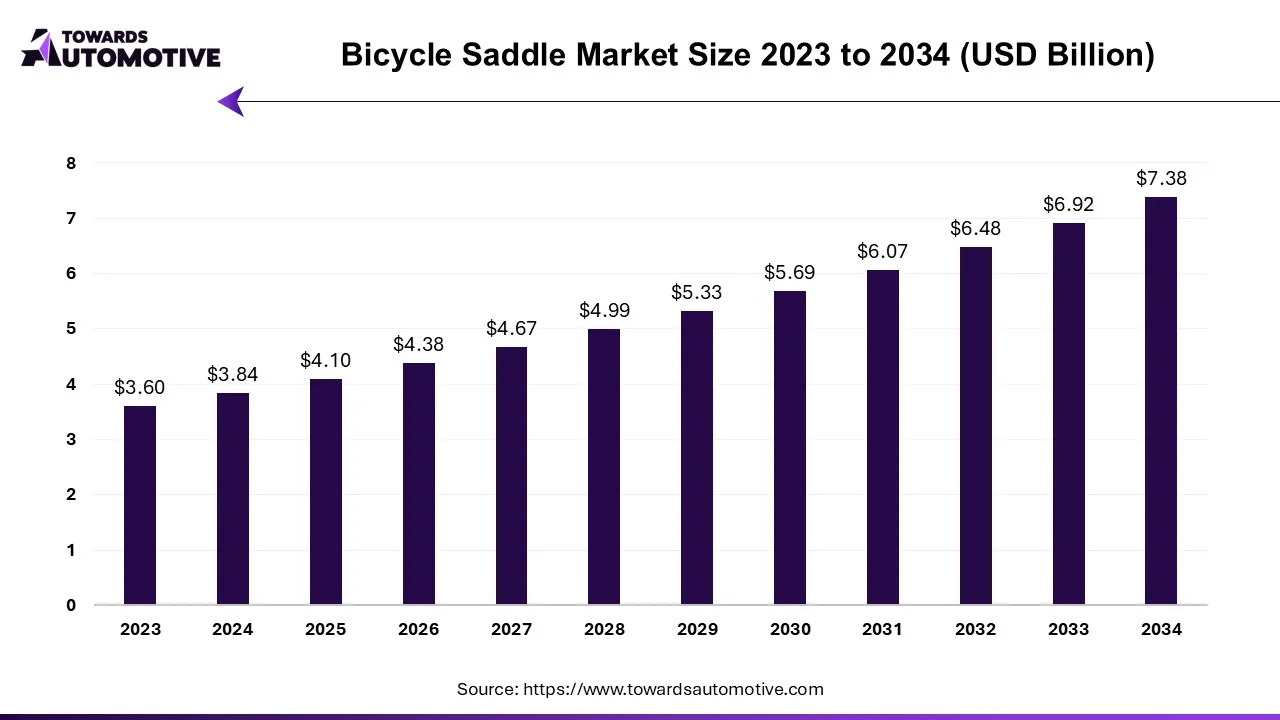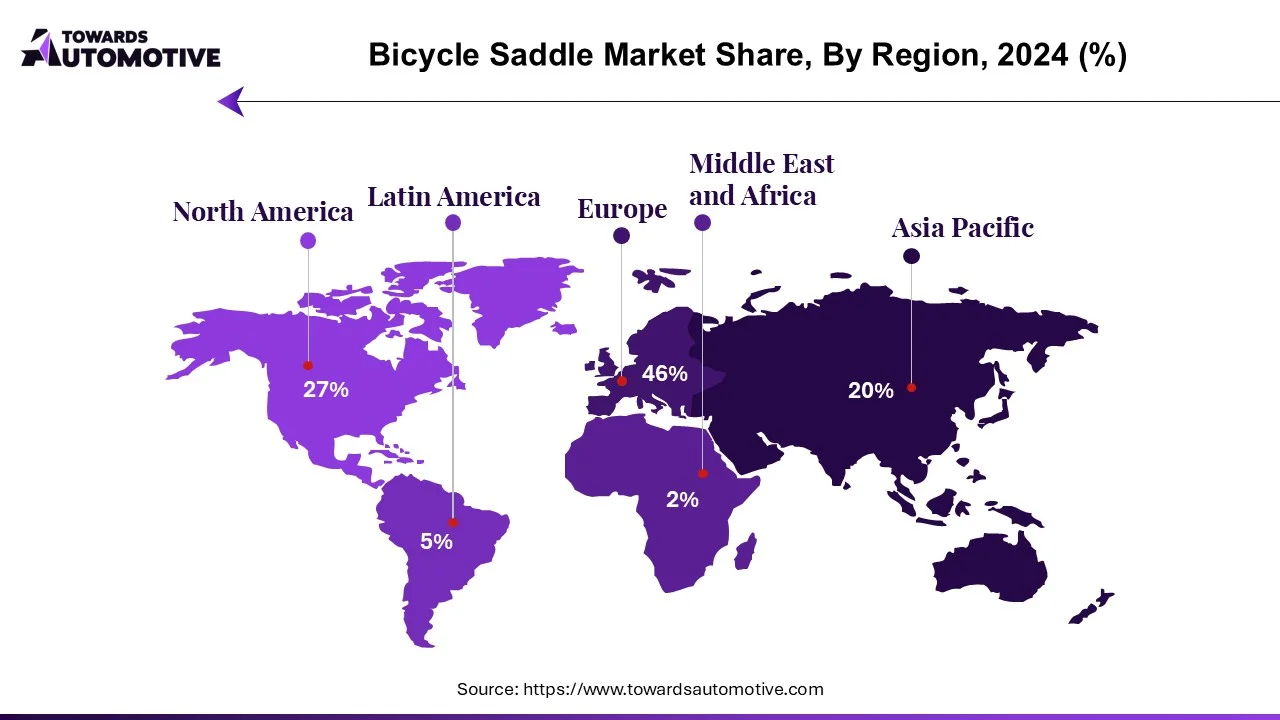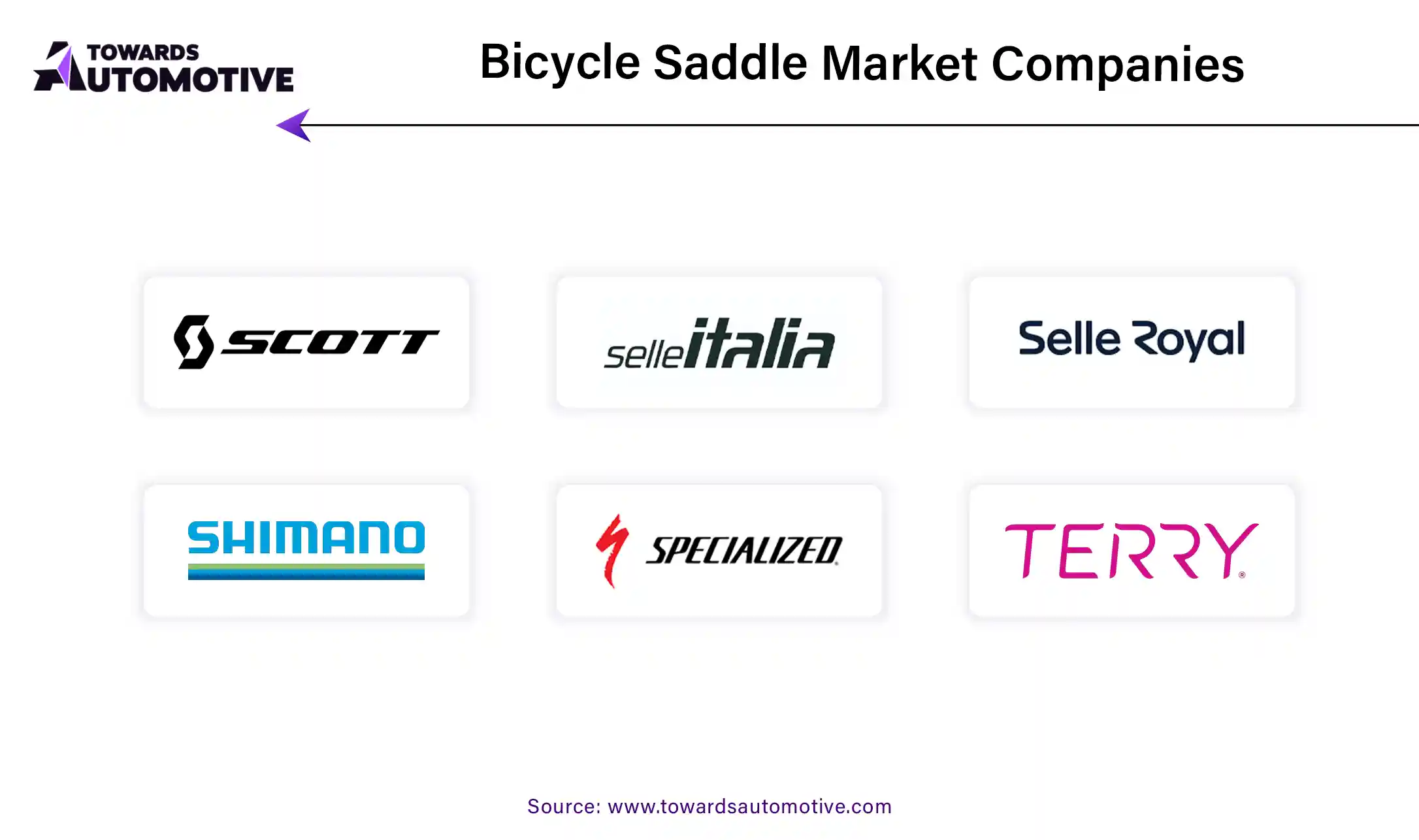October 2025
The bicycle saddle market is predicted to expand from USD 4.10 billion in 2025 to USD 7.38 billion by 2034, growing at a CAGR of 6.75% during the forecast period from 2025 to 2034.

In recent years, the bicycle saddle market has witnessed significant advancements driven by a growing demand for comfort and ergonomic designs among cyclists worldwide. Manufacturers like HUAN have responded to this demand with innovative solutions tailored to specific body types and riding preferences. The launch of the HUAN PPS4 prostate protection saddles in October 2023 exemplifies this trend, offering riders options based on their physique and riding style. Both models feature a double seat structure aimed at reducing contact with nerves under the hip bone, thereby minimizing saddle discomfort—a common issue faced by cyclists during long rides.
Furthermore, advancements in technology and materials have revolutionized saddle design, paving the way for lighter, more durable, and performance-oriented products. Selle Italia's introduction of the Nubuck collection in July 2023 is a prime example of this innovation. The collection, comprising special versions of their renowned SLR, Flite, and Novus models, incorporates unique nubuck material that not only distinguishes these saddles in the market but also offers a dynamic experience. The material seemingly adapts to the rider's movements over time, enhancing comfort and ride quality. With variations in width to accommodate different anatomies, these saddles exemplify the industry's commitment to addressing diverse user needs.
These advancements, coupled with ergonomic features and enhanced ventilation, are poised to drive further growth in the bicycle saddle market. As consumers increasingly prioritize quality and comfort, manufacturers are motivated to innovate and develop products that meet these evolving demands. However, the proliferation of high-performance, ergonomic saddles comes with a caveat—cost. The premium pricing of these products may deter budget-conscious consumers from investing in quality saddles, potentially limiting market expansion. Nonetheless, the overarching trend towards superior comfort and performance underscores the resilience and potential of the bicycle saddle industry, as it continues to push boundaries and cater to the diverse needs of cyclists worldwide.
The COVID-19 pandemic has presented both challenges and opportunities for the bicycle market, including the segment focusing on saddle development. Initially, the pandemic disrupted global supply chains and manufacturing processes, leading to delays in production and exports. This upheaval affected various components of the bicycle industry, including saddle manufacturers, who grappled with logistical hurdles and decreased operational capacities.
However, amidst these challenges, the pandemic fueled a surge in demand for bicycles as people sought safe and convenient outdoor activities. The desire for alternative modes of transportation, coupled with increased interest in fitness and recreational cycling, contributed to a notable uptick in bicycle sales. Consequently, this heightened demand created a ripple effect across the bicycle accessories market, including saddles.
With more individuals embracing cycling as a means of transportation, recreation, or exercise, there emerged a greater emphasis on enhancing comfort and performance through innovative saddle designs. Manufacturers recognized the opportunity to capitalize on this trend by developing products tailored to the evolving needs of cyclists. This led to increased investment in research and development aimed at producing saddles that offer superior ergonomics, support, and durability.
Moreover, the shift towards remote work and flexible schedules during the pandemic encouraged individuals to explore outdoor activities, including cycling, as a way to maintain physical and mental well-being. As a result, there was a growing interest in accessories, such as saddles, that could enhance the overall cycling experience and encourage long-term engagement in the activity.
COVID-19 pandemic initially posed challenges for the bicycle market, including disruptions to supply chains and production processes, it also created opportunities for growth and innovation. The increased demand for bicycles, fueled by a desire for safe outdoor activities, has stimulated interest in developing products like saddles to improve comfort and performance. As the market adapts to these changing dynamics, manufacturers have the opportunity to capitalize on evolving consumer preferences and drive further advancements in saddle technology.
The Bicycle Saddles market is poised for positive growth from 2023 to 2032, driven by the continuous inclusion of useful data and a heightened focus on sustainability. As consumer demand for eco-friendly products rises, there is a pressing need for saddle manufacturers to increase the use of environmentally friendly materials and recycled materials in their production processes. By adopting sustainable practices and prioritizing environmental stewardship, companies can meet the growing demand for more sustainable cycling products while strengthening the long-term growth prospects of their businesses.
A notable example of this commitment to sustainability is demonstrated by Selle Italia, which expanded its environmentally friendly Greentech product line in June 2023 with the launch of the Model Y saddle specifically designed for mountain bikes. Greentech production processes employed by Selle Italia are renowned for their low environmental impact, characterized by mechanical assembly methods that eliminate the use of harmful substances such as adhesives or solvents. Additionally, the materials used in the Model Y saddle can be recycled at the end of their life cycle, further enhancing its eco-friendly credentials.
Designed with off-road performance in mind, the Model Y saddle features a mid-profile structure that supports the rider's pelvic rotation, thereby facilitating improved mobility during off-road excursions. This emphasis on functionality underscores Selle Italia's commitment to not only sustainability but also performance and user experience, aligning with evolving consumer preferences in the cycling market.
By incorporating sustainable practices and utilizing environmentally friendly materials, companies like Selle Italia are not only meeting consumer demand for more eco-conscious products but also contributing to the overall growth and resilience of the Bicycle Saddles market. As awareness of environmental issues continues to rise, businesses that prioritize sustainability stand to benefit from a competitive edge and increased consumer loyalty, driving positive growth and shaping the future of the industry.
According to the project, the bicycle segment is projected to comprise more than 30% of the market by 2022, underscoring its significant role in enhancing passenger comfort and performance. Cycling often entails prolonged periods spent in the saddle, making the quality of the saddle crucial for reducing discomfort and mitigating issues like saddle pain.
Furthermore, advancements in saddle design and materials have led to improvements in aerodynamics and reduced weight, contributing to an enhanced riding experience. Given that cyclists prioritize speed and durability, selecting the appropriate saddle has emerged as a critical component of cycling.
In terms of market distribution, the bicycle saddle market is anticipated to represent approximately 37% of the overall bicycle market in 2022. This emphasizes the importance of saddles within the cycling industry. Recognizing that comfort is subjective and varies from person to person, most consumers prefer to select their saddles individually. Bike shops play a pivotal role in this process by offering opportunities for hands-on testing and expert guidance. Additionally, these stores often provide express delivery services, facilitating a seamless and efficient experience for riders seeking the ideal saddle for their preferences and needs.
In 2022, the European bicycle seat market contributed 29% of the total revenue in the global bicycle saddle industry. This significant market share reflects the growing interest in cycling as a recreational activity, mode of transportation, and means of exercise across Europe. The continent's diverse landscapes, cycling-friendly infrastructure, and cultural emphasis on health and well-being have all contributed to the rising popularity of cycling destinations.

As individuals prioritize their health and seek ways to incorporate physical activity into their lifestyles, there is a notable trend towards purchasing more comfortable and ergonomic saddles for extended journeys. Cyclists are increasingly aware of the importance of saddle comfort in enhancing their overall riding experience, particularly during long-distance rides.
Prestigious cycling events like the Tour de France, as well as local cycling competitions held throughout Europe, have played a significant role in expanding the reach and appeal of the sport. These events not only attract professional cyclists but also inspire amateur riders and enthusiasts, driving up the demand for quality saddles in the region.
Overall, the European bicycle saddle market is thriving, fueled by a combination of factors including the continent's cycling culture, growing interest in health and well-being, and the influence of prominent cycling events. As cycling continues to gain momentum as a favored recreational and competitive activity in Europe, the demand for comfortable, ergonomic, and high-performance saddles is expected to remain robust.

Major companies operating in the bicycle saddle industry are:
ISM and SCOTT Sports SA are indeed recognized leaders in the bicycle seat industry, distinguished by their commitment to innovation, quality products, and customer satisfaction.
ISM stands out for its innovative lasso-less and isolated saddle design, which prioritizes body comfort and pressure relief. This unique design has garnered significant popularity among cyclists, particularly those involved in disciplines such as triathlons and time trials. By focusing on maximizing comfort and minimizing pressure points, ISM saddles have earned a reputation for enhancing performance and endurance during long rides.
On the other hand, SCOTT Sports SA is renowned for offering a diverse range of high-quality saddles that incorporate advanced materials such as carbon fiber. SCOTT saddles are celebrated for their durability, performance, and precision engineering. The utilization of carbon fiber allows SCOTT to produce lightweight yet robust saddles that meet the demands of professional cyclists and recreational riders alike. SCOTT's commitment to utilizing advanced materials and innovative design ensures that their saddles deliver exceptional performance and comfort across various cycling disciplines.
Both ISM and SCOTT Sports SA exemplify excellence in the bicycle seat industry, setting the standard for innovation, quality craftsmanship, and customer satisfaction. Their respective focus on unique design features and advanced materials underscores their dedication to providing cyclists with superior products that enhance their riding experience. As leaders in the industry, ISM and SCOTT continue to drive innovation and push the boundaries of saddle design, catering to the evolving needs and preferences of cyclists worldwide.
By Material
By Activity
By Distribution Channel
By Geography
October 2025
October 2025
September 2025
September 2025
We offer automotive expertise for market projections and customizable research, adaptable to diverse strategic approaches.
Contact Us